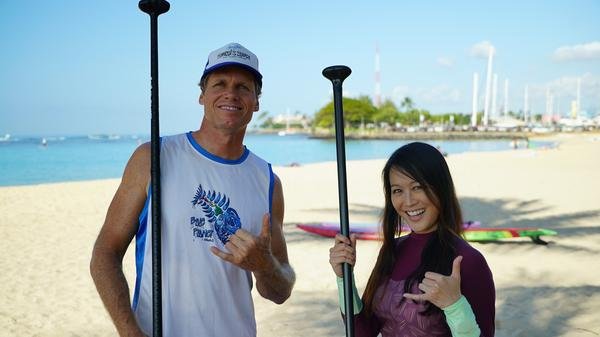Cart
You have no items in your shopping cart

How To SUP with Verena Mei
Learn how to SUP with Verena Mei and Blue Planet Surf.
Verena is a professional race car driver who grew up in Hawaii and recently moved back to Oahu. She got into Stand Up Paddleboarding and has been a great customer and supporter of Blue Planet Surf Shop. In this series she is getting tips on safety, technique, board handling and more from Blue Planet Surf founder Robert Stehlik. This series of 11 videos covers all the basics of Stand Up Paddling and also goes into some more advanced stroke technique. It's basically like getting a private SUP lesson for free, compliments of BluePlanetSurf.com.
Here is the first video in the series:
How to Stand Up Paddle Board with Verena Mei, Part 1: Safety
SUP is a great, fun, health and safe sport if practiced with some common sense.
Basic points covered in this video are:
1) Be aware of conditions. When you are starting out, light wind and protected water are the best conditions for learning quickly. Light winds are fine but the chop created by the wind will make balancing more difficult and you should always make sure to paddle into the wind first to make sure you can get back to where you started. Don't go out if the wind is strong, offshore winds (blowing you away from the shore) can be very dangerous as they can carry you out to sea and usually get stronger the farther out you get.
2) Always wear a leash. In Hawaii we are not required to wear a personal floatation device when Stand Up Paddle boarding but you should always wear a good leash and make sure it is attached securely, that way your boards is always attached to you and acts as your floatation device.
3) Know how to swim. This should be self explanatory, but before you learn how to SUP, you should learn how to swim first. The rule of thumb is: don't go out further from shore than you could swim back on your own power.
This is the second video in this series: board handling and gear
In this video we cover how to protect your board from heat and fin damage, how to safely lift up and carry your board and some things to consider when choosing your first board. At Blue Planet we always recommend trying several SUP's before choosing one as nothing beats trying a board to get an idea of whether it will work for you or not. Balancing should be challenging at first, as your balance quickly improves. We often talk to customers that bought their first board without trying it first and then finding out that it is just not a good board for their needs. Let's face it, it does not matter how cheap a board is or how great the deal seems to be, if you don't enjoy using the board and it sits around collecting dust, it's a waste of money. We want you to get out on the water and enjoy your board, so we want to make sure you get one that is right for you.
Click here for more information on how to choose the right board and watch the video.
Click here for more information on our free SUP Clinics for Blue Planet customers.
A common mistake made by beginners is holding the paddle backwards, this video shows how to angle the paddle correctly and why:
Being able to steer the board is very important, this video covers steering (or sweeping) strokes vs. forward strokes and how to turn the board:
This video goes over how to stand up on the board without losing your balance:
Falling in is part of learning, this covers how to fall in safely and how to get back on the board easily:
Most beginners tend to "grab" the board with their toes, this covers how to keep your feet from going numb or cramping and how to move your feet on the board:
This video goes into slightly more advanced stroke technique: feathering (twisting the blade when exiting the water) makes the stroke much smoother and more efficient and the sooner you learn it, the easier it is to learn it. When we coach more advanced paddlers that have been paddling for a long time without feathering, it is very difficult for them to adjust their stroke, so try to learn this right from the start:
The five phases of the Stand Up Paddle stroke: Catch, Power, Exit, Recovery:
Doing the twist: using less of your arms and more of your torso and core muscles to power your stroke:
Making your stoke more efficient by reaching forward and keeping the power phase in front of your feet, where it is most efficient:
We hope you enjoyed this series of videos, please subscribe to our youtube channel and watch our latest videos, we post new videos on a weekly basis.
Aloha, Robert Stehlik and Verena Mei

Comments
Be the first to comment...